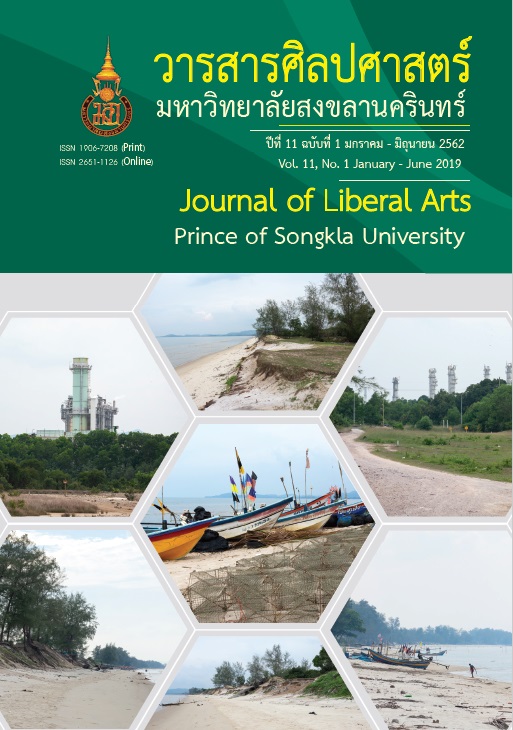Confirmatory factor analysis of the process of change on exercise behavior of working-age population
Keywords:
Confirmatory factor analysis, exercise behavior, process of changeAbstract
The purpose of this research was to analyze and validate the process of change of exercise behaviors on working-age people with empirical data. Data were collected from 389 employees of Chotiwat Manufacturing Industry Co., Ltd. randomly selected using cluster random sampling. The research instrument was a questionnaire on the process of change of exercise behaviors with 30 items. The reliability of the questionnaire was .94. The data were analyzed with second order confirmatory factor analysis. The results showed that the process of changing exercise behaviors among the working-age people had two main components: 1. Cognitive/experiential processe, and 2. Behavioral process, and each of these factors consisted of five indicators which were consistent with the empirical data: (c2 = 22.330, df =16, p-value = 0.133, c2/df = 1.396, GFI = 0.989, AGFI = 0.961, RMR = 0.015, SRMR = 0.021, RMSEA = 0.032, CFI = 0.998). The weight of each factor was between .96 - .97, and the standard weight of each indicator was between .63 - .90.
References
Bernard, P., Romain, A. J., Trouillet, R., Gernigon, C., Nigg, C., & Ninot, G. (2014). Validation of the TTM processes of change measure for physical activity in an adult French sample. International journal of behavioral medicine, 21(2), 402-410.
Blaney, C. L., Robbins, M. L., Paiva, A. L., Redding, C. A., Rossi, J. S., Blissmer, B., & Oatley, K. (2012). Validation of the measures of the transtheoretical model for exercise in an adult African-American sample. American Journal of Health Promotion, 26(5), 317-326.
Boonchuaykuakul, J.(2005). Effectiveness of applying the transtheoretical model to improve physical activity behavior of university students. Doctoral dissertation, Oregon State University.
Dishman, R. K., Jackson, A. S., & Bray, M. S. (2010). Validity of processes of change in physical activity among college students in the TIGER study. Annals of Behavioral Medicine, 40(2), 164-175.
Hair, J. F., Black, W. C.,Babin, B. J., & Andrson, R. E. (2010). Multivariate data analysis (7th ed.). NJ: Prentice-Hall.
Hwang, J., & Kim, Y. H. (2011). Adolescents' physical activity and its related cognitive and behavioral processes. Biology of Sport, 28(1).
Jamornmann, U. (1994). Sampling techniques in educational research.Bangkok: Funny Publishing. [In Thai]
Katewongsa, P., & Choolert P. (2017). The effectiveness of sedentary behavior and screen-time behavior reduction model for adolescents. Academic Journal Bangkok Thonburi University, 6(2), 124-137. [In Thai]
Lee, J. H., & Kim, Y. H. (2015). Adolescents’ exercise behavior and cognitive and behavioral variables. International Journal of Innovative Science, Engineering & Technology, 2(2), 347-351
Massey, W. V., Meyer, B. B., & Mullen, S. P. (2015). Initial development and validity evidence for the processes of change in Psychological Skills Training Questionnaire. Psychology of Sport and Exercise, 16(3), 79-87.
Nigg, C. R., Norman, G. J., Rossi, J. S., & Benisovich, S. V. (1999). Processes of exercise behavior change: Redeveloping the scale. Ann Behav Med, 21, S079.
Nigg, C. R., & Riebe, D. (2002). The transtheoretical model: Research review of exercise behavior and older adults. In M. P. Burbank & D. Riebe (Eds.), Promotion exercise and behavior change in older adults: Interventions with the transtheoretical model (pp. 147-180). New York: Springer.
Panidchakul, K., & Boonsin S. (2010). Determinants of readiness to adopt regular physical activity among working-age people: A transtheoretical model. Journal of Public Health Nursing, 24(2), 48-66. [In Thai]
Paxton, R. J., Nigg, C. R., Motl, R. W., McGee, K., McCurdy, D., Matthai, C. H., & Dishman, R. K. (2008). Are constructs of the transtheoretical model for physical activity measured equivalently between sexes, age groups, and ethnicities?. Ann Behav Med, 35(3), 308-318.
Prochaska, J. O., & DiClemente, C. C. (1983). Stages and processes of self-change of smoking: Toward an integrative model of change. Journal of Counseling and Clinical Psychology, 51, 390-395.
Romain, A. J., Bernard, P., Hokayem, M., Gernigon, C., & Avignon, A. (2016).
Measuring the processes of change from the transtheoretical model for physical activity and exercise in overweight and obese adults. American Journal of Health Promotion, 30(4), 272-278.
Strategy and Planning Division, Office of the Permanent Secretary (2014). Health status. Retrieved May 23, 2018, from http://bps.moph.go.th/new_bps/healthdata.
Tirakanant, S. (2007). Creating a variable measurement tool in social sciences research: A practical approach. Bangkok: Chulalongkorn University Printing House. [In Thai]
World Health Organization. (2010). World health statistics 2010. Retrieved May 23, 2018, from http://www.who.int/gho/publications/world_health_statistics/EN_WHS10_Full.pdf.
World Health Organization. (2013). World health statistics 2013. Retrieved May 23, 2018, from http://www.who.int/gho/publications/world_health_statistics/EN_WHS2013_Full.pdf.
Downloads
Published
How to Cite
Issue
Section
License
The authors retain the copyright to their article but the Journal of Liberal Arts, Prince of Songkla University reserves the exclusive rights to first publication.





